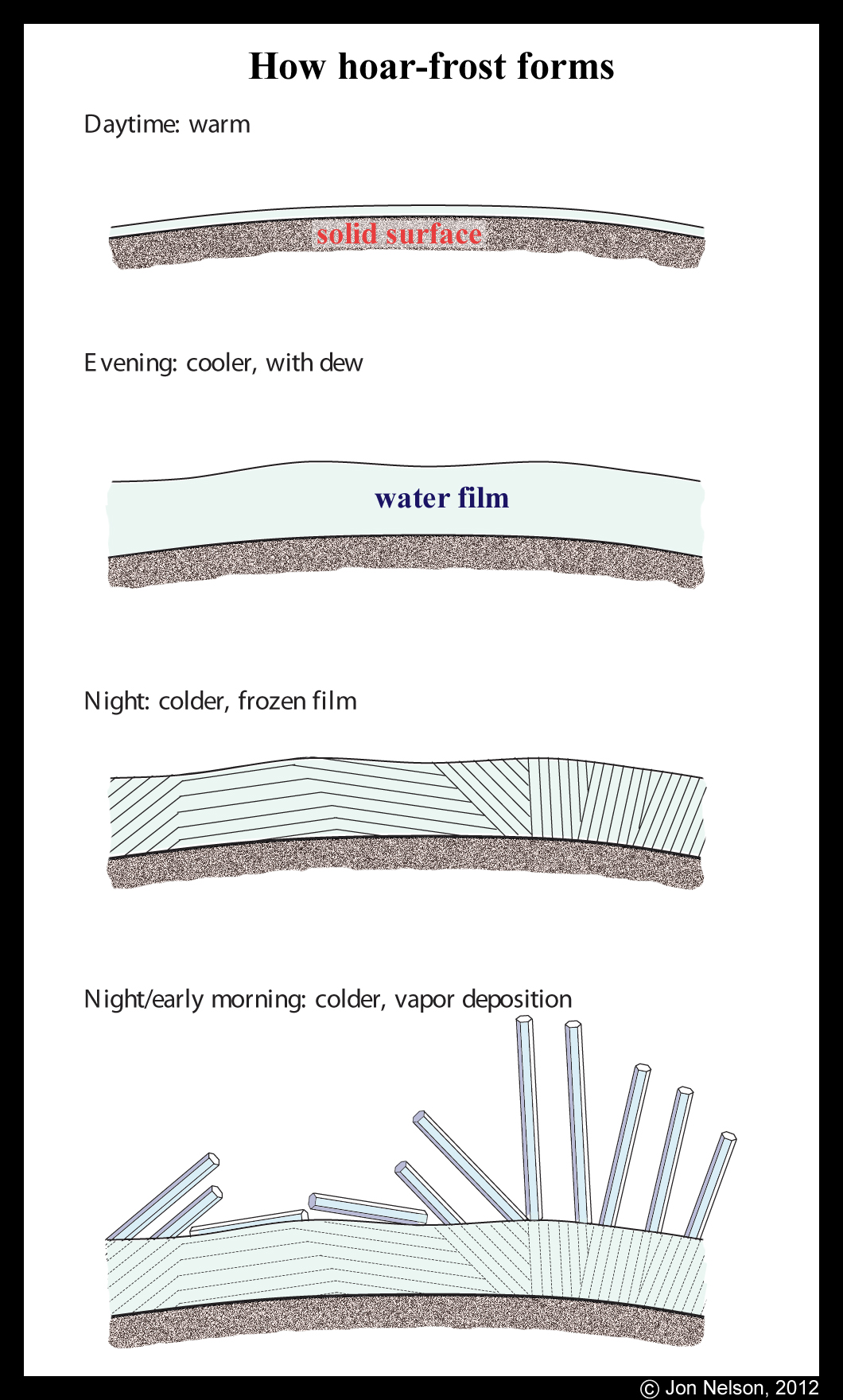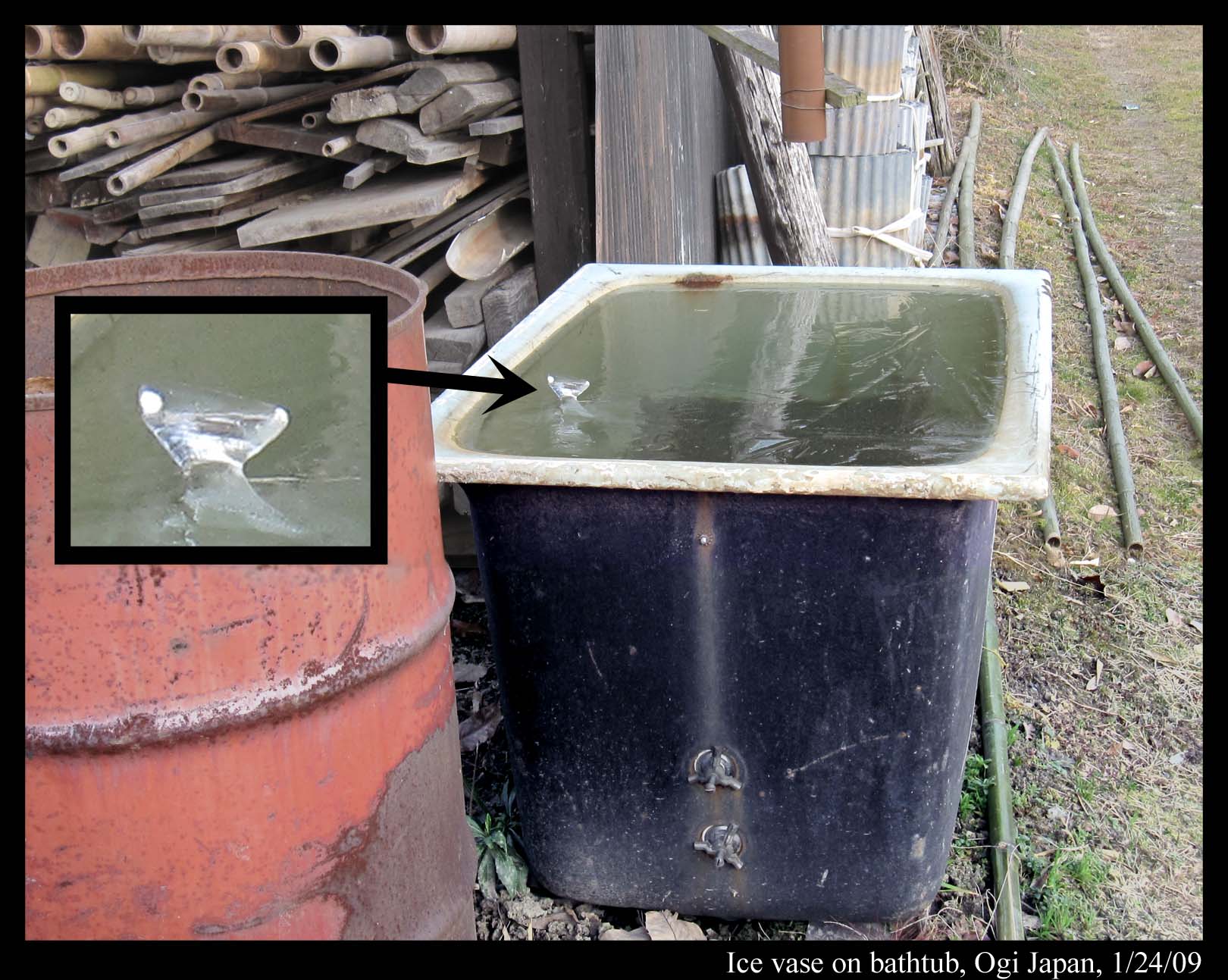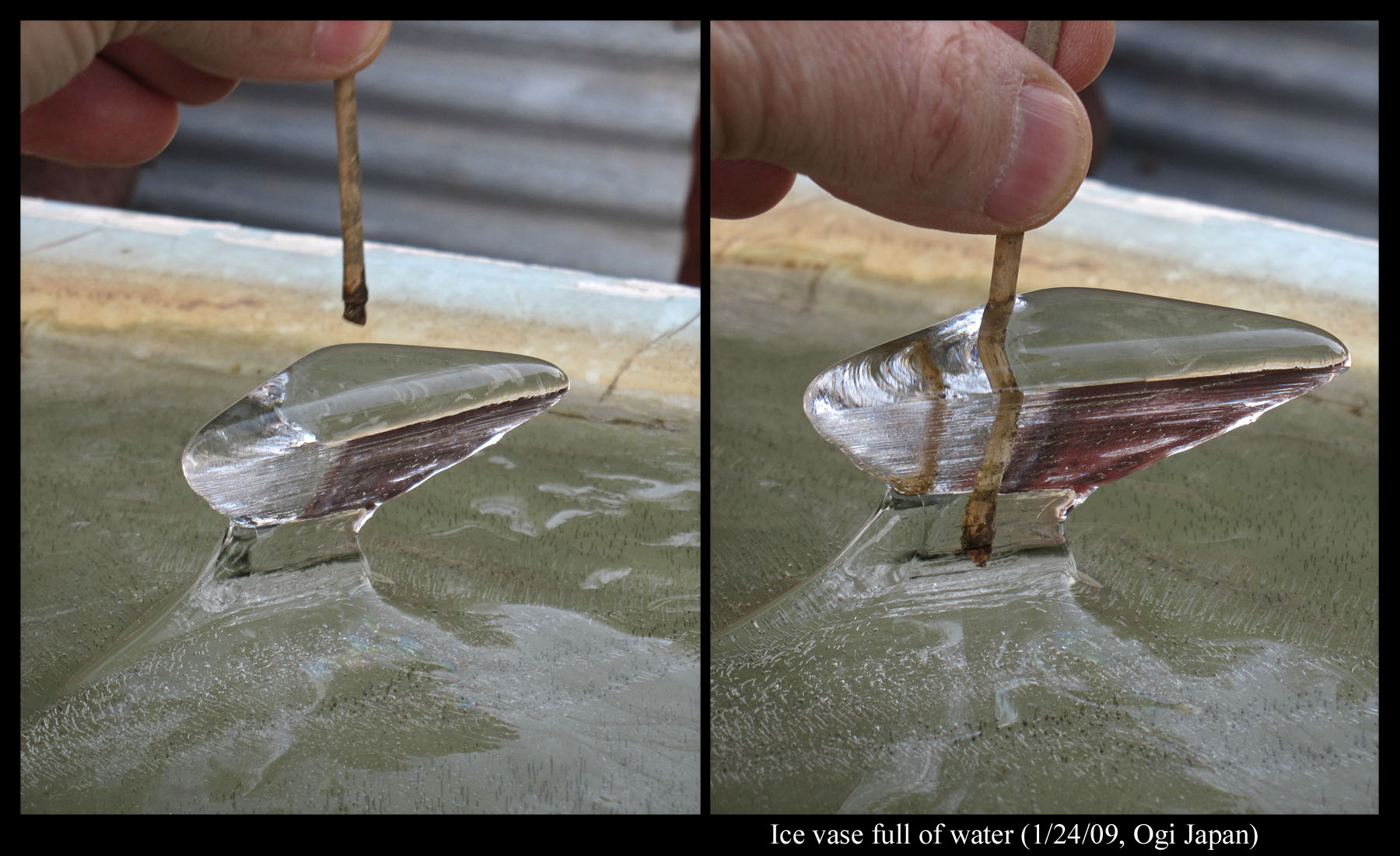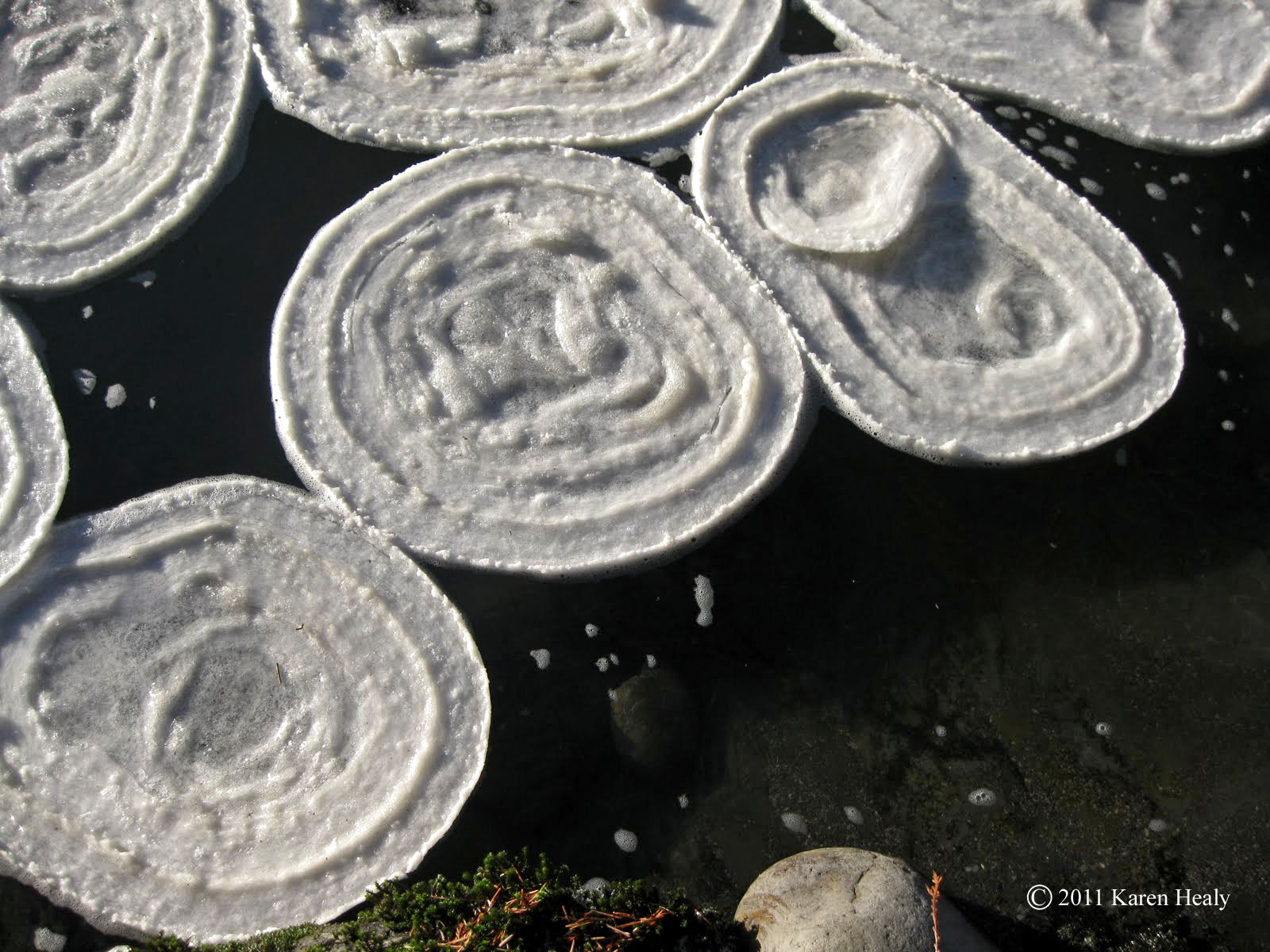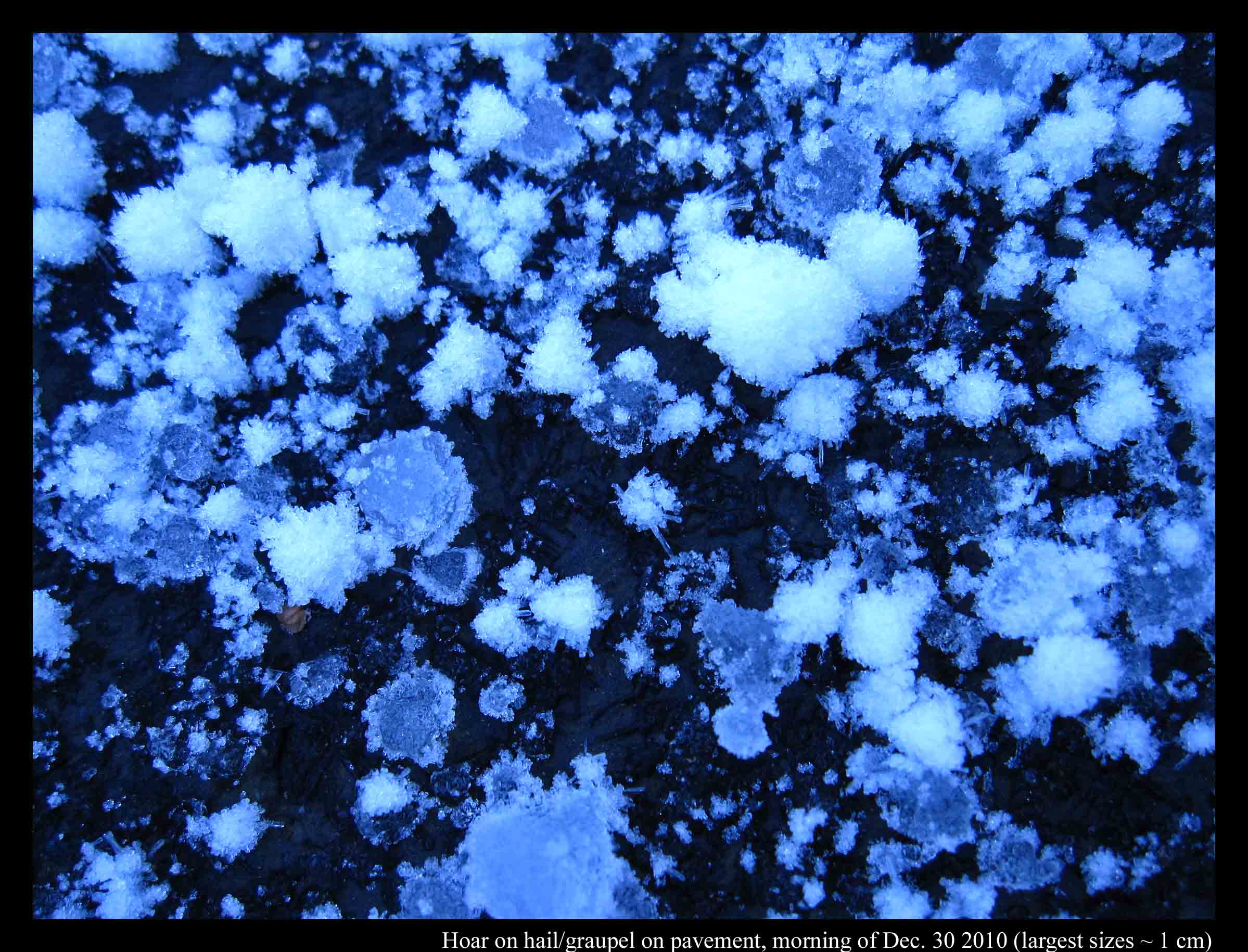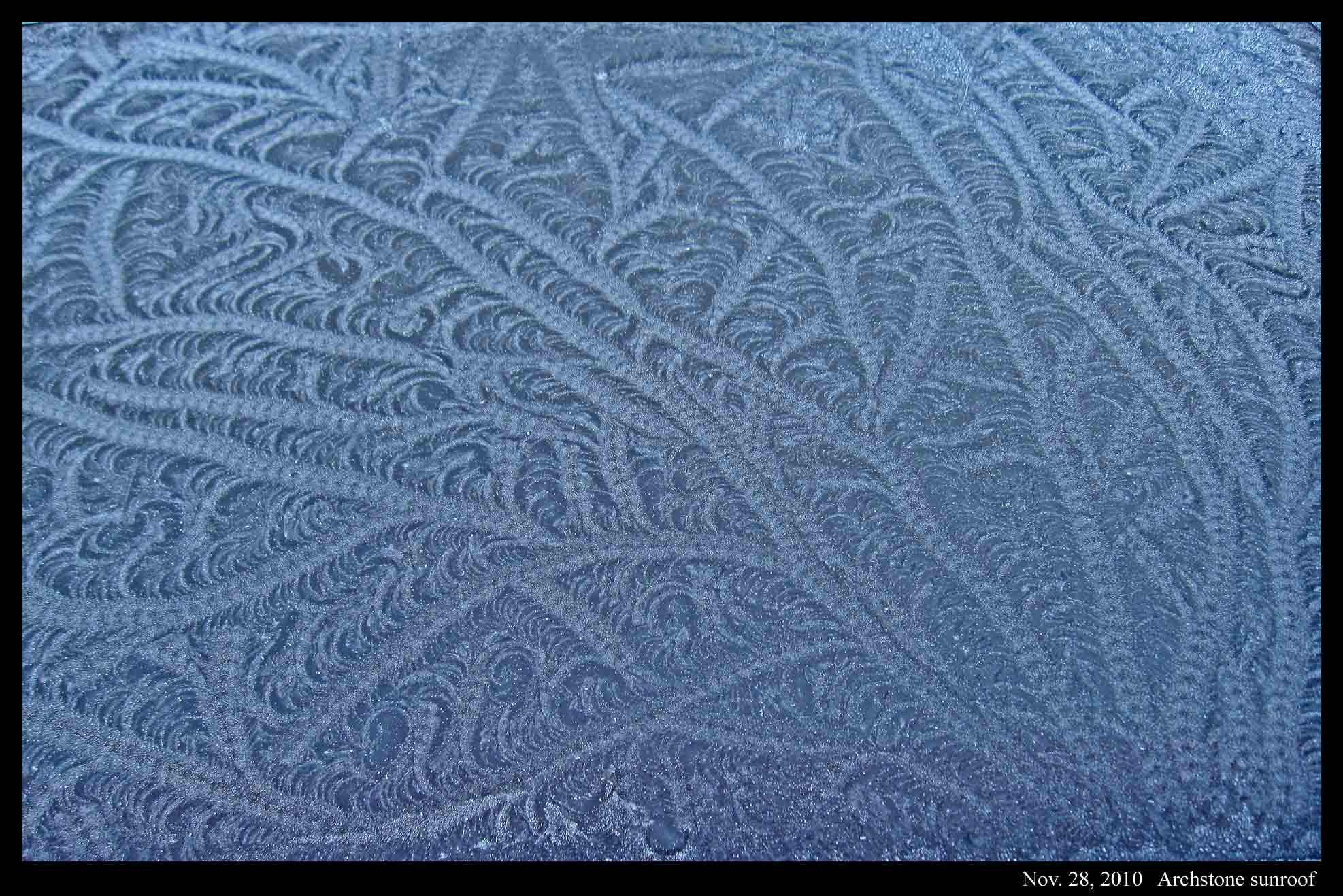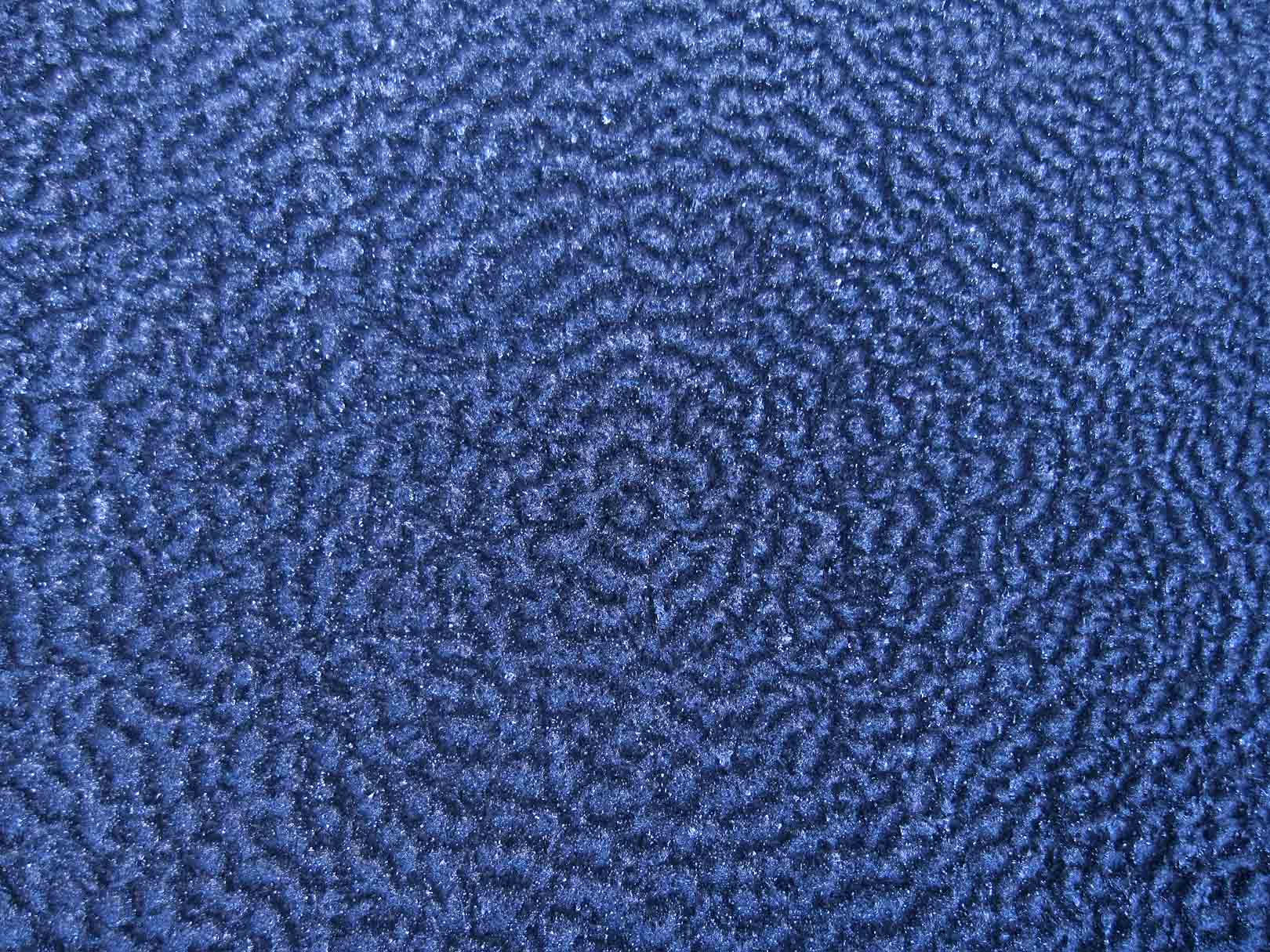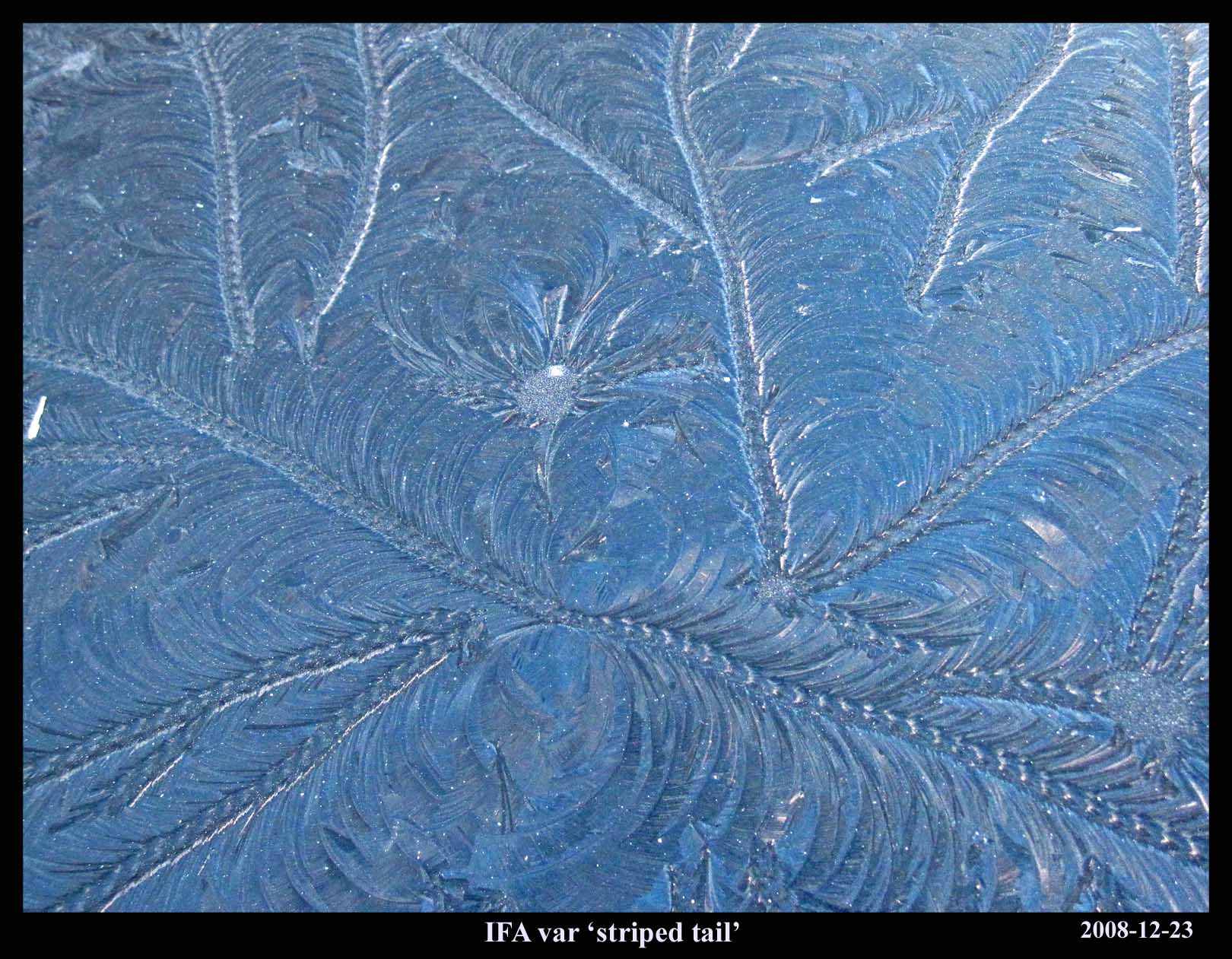Category: "Ice Science"
Choppy waves
January 11th, 2012I thought this hoar frost pattern looked like rough seas. I see choppy, cusp-like waves down there.
Not having any pictures of rough seas, I hopped in our bathtub and kicked my legs around to make waves. Perhaps you can see a little resemblance.
However, the processes that caused the cusp-like, choppy wave pattern in the frost are completely different from those in the bathtub. Look more closely at the hoar-frost pattern:
It just goes to show you that hoar frost is never as simple as you’d think. Though from a distance it might look like white whiskers, up close it shows unexpected patterns. These patterns reveal something about how the crystals strained, twisted, and competed with each other.
Though it is true that the hoar crystals we see are built of deposited vapor molecules (invisible water molecules once floating in the air that happened to strike and freeze onto a cold surface), the story of hoar has an earlier beginning. In the beginning, the surface already had a thin film of liquid water. See the top panel in the sketch below.
An Ice Vase Sprouts From a Bathtub
February 6th, 2011Someone recently sent me a beautiful image of an ice structure in the shape of a vase. The vase in that case had somehow sprouted out of a frozen birdbath. The thing reminded me of an ice vase I once found on an old plugged-up bathtub in a farmer’s field in Japan. See the photo below.
On approaching the tub, I first thought the ice bump on top was some chunk that had fallen off the roof and refrozen. But on closer view, I found that the thing had sprouted out of the surface. How did I know? Well, as I leaned over it, my body pressed against the tub wall, and I noticed something move. Turned out it was water on top, filling up the vase to the brim! See the sequence below.
Clearly, I’m not pushing that flimsy twig through solid ice.
Of all the curious things I’ve seen here, never before nor since did I see something like this water-filled ice vase. However, the vase forms in much the same way as the somewhat-more-common “ice-cube spikes” that sprout from ice cube trays. But how do such spikes and vases form?
Ice Forms on Slow-moving Water II: Pancakes and Frozen Foam
January 16th, 2011An acquaintance of mine recently discovered these odd discs of ice.
The discs floated freely in an eddy behind some fallen logs on the Nooksack River’s south fork. See other photos and a short video at
http://picasaweb.google.com/karenhealy11/January12011IceFloes#5557968238304251890
What we think happened is this: Foam floating about on the water, which you can see in the video, started to freeze, probably at night. Bits of frozen foam got pushed around in the eddy, and in the ensuing collisions, became roughly circular. Perhaps each disc grew radially when smaller pieces of unfrozen foam struck the disc, adhered and spread out a bit along the perimeter, and then froze in place.
The raised rims are undoubtedly due to the collisions. One sees such rims on “pancake ice”, which is also said to be due to collisions, but what about the concentric raised regions inside the discs? None of the images of pancake ice on Google seem to show these inner lines.
Here’s an idea about those lines. The air temperature oscillated during the growth of these discs: colder at night due to the clear-sky conditions and resulting radiative cooling, but warmer in the day. The discs may have grown at night, collecting new foam, then during the day, when the discs softened in the sun, softening particularly around the edges, the collisions raised up the rims. The next night, further radial growth followed by a new rim the next day at a greater radius. The pictures and video show 4-5 such rims, indicating growth over 4-5 days, which is roughly consistent with the duration of our cold snap.
- JN
Ice Forms on Slow-moving Water I: Caterpillars and Cellular Dendrites
January 15th, 2011During my last winter in Japan (2009-2010), I would walk around a neighborhood park on frosty mornings, looking for interesting ice forms. It was in this park that I found one rock (only one!) that on some mornings would sprout hair-like ice, arising from liquid water within (see the last images in my “Ice on the Rocks” post, Jan 27). This park also has a small, slow-flowing brook that, despite the relatively warm conditions, often freezes over. Usually, upon freezing, it shows an ice pattern consisting of many long (~ one foot) straight lines – a typical pattern you usually see on glaciated puddles and ponds. But on the morning of February 4, at one spot right before the water tumbled over a waterfall, the ice surface looked slightly different. It had lines, but the lines were short, thick, and bumpy (see photo below), looking a bit like black-blue caterpillars scattered about.
From the small bridge spanning the brook, I reached down, pulled some ice out, and was shocked at what I saw. This was not “solid” ice, but rather a bunch of very thin ice plates loosely resting on each other – somewhat like a deck of cards spread out in a fan, though in this case, each ice plate had its own size and shape. Also, unlike other thin ice plates I’d seen before, these ones resembled neither the fast-growing ice dendrites (the snow-crystal-like, branched forms) nor the slow-growing ice discs. The photo below also shows that the plates were big – the section shown being several inches across.
Over larger streams and faster-moving water, ice can develop into something called frazil ice. I’ve no experience with frazil ice, never having lived in a cold-enough region, but I this caterpillar ice may be different. For one, the water was extremely slow-flowing. I could not discern the flow, even in ice-free regions, whereas the descriptions I’ve read about frazil ice involve easily discernable flow rates, flow rates that introduce turbulence, crystal collisions, and mixing below the surface. Also, the ice crystals I saw were much larger than the millimeter-sized pieces I see reported for frazil ice. So, the caterpillar form might be a transitional form, between frazil and that over stagnant water.
Hoared Hail and Coraline Cups
December 31st, 2010As far as I could tell, nobody had predicted hail last night, yet there it was on the ground, the largest hail I’ve ever seen here in the northwest. It fell on wet ground, freezing to the surface and then growing hoar columns, making the ground white and crunchy.
The parking lot in front of our apartment was covered in ice, mostly clear (i.e., "black") ice, yet, because of the ice lumps, it was not slippery under my boots. I kept expecting to slip, but never did. On the curb, where it was a little colder, the hoar was much thicker, looking like an inch of snow.
Same story for the tops of cars, where it had been coldest. The temperature was such that the hoar was mainly columnar. Columnar hoar, indeed all hoar, grows just like snow – when an excess of water molecules deposit from the vapor – and yet columnar hoar tends to develop more in the “cup” (C1b) and “scroll” (C1i) forms (see my Feb. 14 posting for the meaning of the symbols).
But unlike the pencil-like columnar forms of falling snow, these cups and scrolls grow broader at their growing end, even branching out into a pattern a bit like coral.
And if you look closely at the above shot, you will see that the “branches” grow along the same axis as the crystal from which they sprout. (For the above shot, I put a piece of black cloth in back to show the boundaries more clearly.) Such branching contrasts with that for tabular crystals, such as the ones on the familiar six-branched snow crystal.
Why do the columns widen at their growing ends, thus making a cup-shape, why do the cup rims sometimes curl into scrolls, and why do they branch out? I suspect the reason for all three (though not a complete reason) is that the humidity next to the growing crystals is very high – higher than that surrounding the typical column form that drops from the sky. Unlike the latter case, where the humidity is too low for the prismatic faces to grow outward, at least at any rate near that of the basal, here both the basal and prismatic faces grow at comparable rates. Such growth behavior also depends on the temperature, for reasons that still elude us.
- JN
More Tales of Mystery and Observation
December 1st, 2010When I stepped out early Saturday morning, the air seemed relatively warm, particularly compared to the cold snap we had last week. Indeed, it was much warmer, and yet the parking lot in our apartment complex had a glaze that was much more dangerous than that during the cold snap.
But it was the frost that I noticed. Of course, the air was relatively warm, but the clear sky cooled the surface. Recently, snow melted, leaving plenty of open water to evaporate – perfect conditions for film frost and hoar.
I saw “striped-tail” film frost(1) on two car roofs, both times on the sunroof glass. Why only on the glass? Perhaps the glass, being a poorer conductor of heat, had a lower surface temperature. This lower temperature would have produced a thicker film of water, and the thickness of the film seems to influence the pattern. The bigger mystery though is the cause of the pattern. In a short online article(2) last year, I suggested a cause for the stripes on each tail, though I can offer no explanation for either the nearly uniform width of the tails or the meandering. In the case below, the pattern is dense with lazily wandering striped tails. When I look at it, I think of seaweed. The metal car surfaces often had nice curving film-frost with dense hoar, while others had or condensed droplets with more isolated, spiky hoar. The latter appeared on my own car.
The Window of Many Cacti
February 14th, 2010The resemblance may be a bit more obvious in the following shot, which I took two years ago on seeing this form for the first time.
Ripples
February 5th, 2010When there is no pebble tossed
No wind to blow
--Grateful Dead “Ripple”
I don’t know where to start on this one. For some time I’ve been seeing concentric circular patterns on car windshields and car bodies – bands of white spreading out from a central point like ripples in a pond from a tossed pebble. Typically, they spread outward 3-10 inches or so before meeting up with ripples originating from another spot.
When I try to zoom in on the individual crystals, I usually see only vague outlines with the occasional recognizable form. What could cause this pattern? Here's a clue.
Mystery of Whirlpool Hollows
February 3rd, 2010The hollow columnar crystals are oriented lengthwise along concentric circles, which strongly suggests that an underlying film froze with the same rotating crystal orientation. This is strange. To see why I think it strange, we need to specify crystal direction. Consider the ice-crystal optic axis, the length-wise direction of the columns (or the direction straight into a stellar-star crystal). If we draw the optic axis for each crystal as an arrow, then we would have something like the following picture.
When a film of water on a smooth surface like glass or a car roof freezes, the preferred crystal orientation is that with the arrow pointing straight up and out of the surface. So, I find the above pattern mysterious - why don't the arrows have any trend toward pointing upward? Why do all the arrows stay in the same plane? Another mystery is the fact that I’ve seen this same whirlpool pattern with about the same center spot on both side mirrors on more than one morning. Perhaps the whirlpool pattern arises somehow because the surface is curved. Or maybe films of water on plastic freeze differently than films on smooth metal or glass. For now, I’ll call this the mystery of whirlpool hollows.
- JN
BEDFISH: Revising an old Idea for Classifying Surface Ice Forms
January 31st, 2010It often seems like people refer to any kind of ice stuck on something as frost. If one looks in books or the Internet, one can usually find a specific term for the many different and interesting ice formations, but a term used by one group of people generally differs from that used by another. Wouldn’t it be nice for scientists and naturalists (at least) to have some generally universal, agreed-upon way to describe any surface-ice formation? Snow crystals have such a system, so why not surface-ice forms?
We could try to establish word-names for each formation, like “frost flower”, but different people are used to using different names for the same thing, and they are unlikely to give up the habit, particularly if they are unfamiliar with the language of the term’s origin. For example, there are several well-used terms for the ice columns in dirt that I discuss in “Ice on the Rocks” including “frost heave”, “needle ice”, "ice columns", and “pipkrake”. But “needles” also names a type of snow. Another example: The white, curly ice hairs that can extrude from plant stems and logs is sometimes called “frost”, “frost flowers”, “Ice flowers”, "needle ice", and “sap crystals”. But the two flower terms are also used for several other, very different things. Though a few terms seem to be used consistently in English, like “hoarfrost” and “icicle”, most aren’t. And probably none work across all languages. So, instead of using word-names, a set of symbols may work best.
Wilson Bentley gave a good start to such a universal code for surface ice way back in 1907. His article “Studies of frost and ice crystals” gave an ingenious method for classifying several types of surface ice [1]. The article is a fantastic source of information about hoarfrost, window-pane frost, and ice that grows in bodies of water like lakes and rivers. Unfortunately, I know of no one except Bentley who ever used his system. This lack of use is probably due to issues unrelated to his system’s merits, so his system might need only a little revision and some promotion to get it into use. My purpose here is to suggest such a revision.
Bentley’s system used three letters to classify many kinds of ice-forms:
Position 1: capital letter giving the kind of frost or place of deposition.
Position 2: capital letter giving the characteristic form of the ice.
Position 3: capital letter giving how common the ice form is.
Position one could be "W" for window frost, "H" for hoarfrost, "I" for window-ice, "M" for massive ice (e.g., ice in puddles, lakes, and rivers), and "S" for hailstones. For short, we could call it the WHIMS system. As an example, the following ice formation is “IFA” in his system.
Although the “I” stands for window-ice, ice on smooth black metal, as in the above case, has similar growth patterns.



